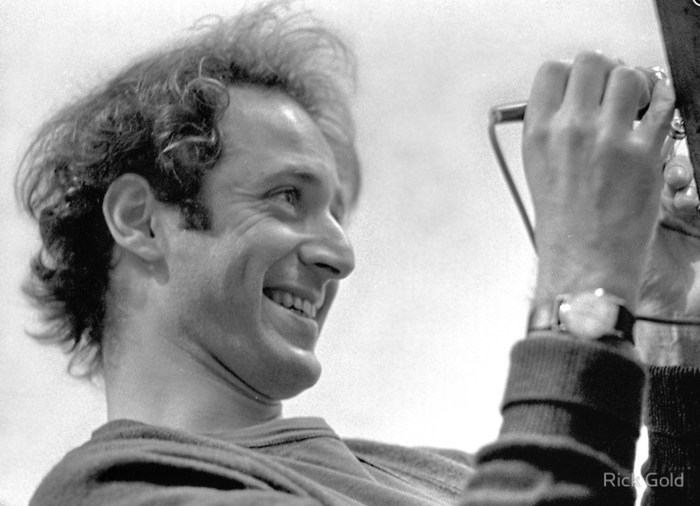Research Studies/Études & Recherche : — [Studies - Multiple Instrument Works / Œuvres à Instruments Multiples ou Égaux] — [Steve Reich - Pendulum]
TAPE PIECES (STEVE REICH)seconde partie / Part 2 |
Oeuvres pour bande / Tape pieces (1964-1965)(Edit)
| One cannot analyze these early pieces without first discussing the political situation and social influences in the United States during the time of his early recordings in the context of the early to mid 1960’s. Reich’s profound respect as a teen for jazz musicians such as Charlie Parker, John Coltrane and Kenny Clarke, contributes to his evolving involvement in the Civil Rights Movement. The influence of this genre is seen best in his early tape pieces. Reich became sensitive to the struggle of the African American as a teenager, and this is strengthened by his approach of The Civil Rights Movement. Reich was not alone in his compassion for this movement. It was not unusual that white, middle-class youth were sensitive to the Civil Rights Movement. Reich became involved with the San Francisco Mime Troupe. The Mime Troupe was already becoming active in the counter-culture staging satirical and later, political productions in San Francisco, the heart of the counter-culture movement in the United States. — (according to Gregg Kowalsky, A Socio-Political Analysis of Steve Reich’s Early Compositions (1963-1966), 1964) | On ne peut pas aborder et analyser les premières œuvres pour bande de Steve Reich sans prendre en compte la situation politique et les dynamiques sociales aux États-Unis au moment où il les élabore et les réalise au milieu des années 60. Le profond respect que le jeune Reich porte aux musiciens de jazz tels que Charlie Parker, John Coltrane et Kenny Clarke, contribue d'une certaine manière à l'engagement qu'il va développer pour le mouvement des droits civiques aux États-Unis. Cette influence liée au jazz et à la politique se ressent dans ces premières œuvres pour bande. Steve Reich devient attentif très jeune à la lutte des afro-américains, ce qui est renforcé par son approche du mouvement des droits civiques. Durant cette époque, Reich n'est pas le seul [artiste] à avoir de la compassion pour ce mouvement. Il n'était pas inusuel en tant que jeune blanc américain de la classe moyenne d'être engagé ou du moins de suivre les revendications de ce mouvement et de relever les injustices présentes dans la société. C'est ainsi que Steve Reich s'est impliqué dans le San Francisco Mime Troupe. Le Mime Troupe était déjà devenu actif dans la contre-culture de la scène californienne avec des productions théâtrales satiriques et politiques à San Francisco, qui était à l'époque le cœur de la contre-culture aux États-Unis. — (selon Gregg Kowalsky, A Socio-Political Analysis of Steve Reich’s Early Compositions (1963-1966), 1964) | |||||||||||||||||
After graduating, Reich remained in the Bay Area for the next two years. He involved himself with four mains areas of musical activity : composing music for the San Francisco Mime Troupe, playing with an improvisation group and — working at his home-based studio — composing both independant tape pieces and some music for underground films and theatre.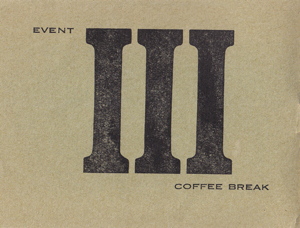 San Francisco Mime Troupe, Event III Coffee Break - sound by Steve Reich and Phil Lesh, 1964 Working with a mono Wollensack, the first commercially available tape recorder in the United States, then a mono Viking, in late 1963 he completed his first piece, the score for an experimental film, by Robert Nelson, called The Plastic Haircut. This sound-collage, produced in parts through looping techniques and overdubbing, used an old LP narrating « The Greatest Moments in Sports » (Recorded especially for Gillette by Columbia Records, 1955). 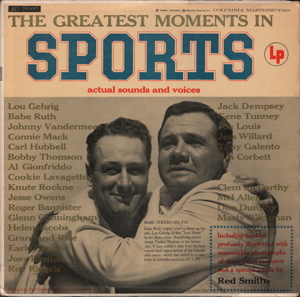 Reich mentioned he was enthusiastic about the ambiguous meanings in the vocal clips this style of recording produced (quoting in Potter 163). Over-dubbing was just one of the recording processes that were developed in the 60’s as with the use of tape recorders. Over-dubbing is just one example of the how the advancements of technology affected music, especially rock music. « I’d record a bit, stop the tape, move the needle, and then start taping again, so there was hardly any splicing », Reich explained to Michael Nyman in 1970. The piece « turned into noise through over-dubbing with loops, rather like a surrealist rondo ». Plastic Haircut begins with cheering crowds in a large stadium with marching bands playing music. From the onset there is an element of chaos as the crowds volume grows in intensity. About thirty seconds into the piece the needle is dropped on a Jack Dempsey boxing match and we hear Jack Dempsey shout “you’re gonna get it if you don’t watch out!” The listener is forced to ask who Reich, through Dempsey, is warning here. One feel the composer is pointing his finger at the establishment. Every vocal clip contains some violent message. The ways in which the clips are arranged enhances this element of violence. We hear, “watch out”, “beatings with baseball bats”, “red-blooded American”, “same old punch”, “punched in succession”. These phrases sound like descriptions of what was happening on the city streets during protests and riots. “Red-blooded American” is particularly poignant — Politically, the Cuban Missile Crisis of 1962 was still fresh in the minds of Americans, who felt the paranoia that the world could end with the push of a button. The composition concludes with an assault of quick cuts of the clips to an elevated amplitude of crowd noise, which build into a wall of noise. There is nothing soothing about this piece. It is violent, aggressive and confrontational as was the time this composition was written. Livelihood (1964) is a three-minute collage assembled from collected sounds, as an evocation of a taxi-driver’s daily life (at that time, Reich drove a taxi cab for a living, though only in San Francisco, not following his return to New York), from stating the destination to casual conversation in the cab, ending with paying the fare and saying ’Thank you’ and ‘Goodnight’ : conversations, slamming doors, meters being thrown, grunts and groans, people hitting their head… the noises that one hears inside of a taxi… Reich destroyed the mastertape of this piece, along with some other material, in the mid-1980s. In the spring of 1964, Reich and his associates played at the San Francisco Mime Troupe Theater. Presented on no fewer than four nights — 21, 23, 29 and 30 May — Koncert I began with three pieces by Reich : Proportional Piece #1 and two improvisations on the Pitch Charts material (‘tape and live version’), performed by a sextet including saxophonist Jon Gibson, trumpeter Phil Lesh (and later Grateful Dead's bassist), keyboardist Tom Constanten, violinist George Rey (who would become known as a philosopher), cellist Gwen Watson and Steve Reich. It was after one of these nights that Reich first encountered Terry Riley and that leads the participation of Reich and other members of his improvisation group in the première of In C on 4 November 1964. Later and as his interest in tape continued to grow, Reich acquired a Sony 770 in 1964, then a state-of-the-art stereo machine, and a Uher portable - both on installment with a co-signer Phil Lesh (the Grateful Dead bassist). Reich ran a mike from the Uher, half the size of an attaché case, tucked under his driver’s seat, up to the dome-light of his cab. Thus he could record conversations in the back of a taxicab he drove. This technique of using voices' fragments (recording, montage), also present in his first sound collage Plastic Haircut, anticipates the more extensive and complex use of phrase and word repetitions in another tape composition, It’s Gonna Rain (1965). The later work, Reich’s first piece employing his phrasing technique, uses a recording of Brother Walter, an African American Pentecostal street preacher, delivering a sermon in San Francisco’s Union Square. In early 1965 Reich also used the ending of Stephan Foster's "Massa's in De Cold Cold Ground" (1852) and set a fragment of his "Oh Dem Watermelons" in five-part canon as part of the Mime Troupe's "minstrel show," presented as in illustration of the racial stereotypes implicit in both the original music and the original minstrel shows. Reich's Oh Dem Watermelons canon accompanied the projection, in the middle of the minstrel show, of a quick-cut film of the same name by Robert Nelson, featuring watermelons flying into Superman's arms, being smashed, being caressed by a naked woman, etc. | Après l’obtention de son diplôme, Reich compose pour la San Francisco Mime Troupe, joue dans un groupe d’improvisation et s’initie à la composition sur bande magnétique dans son studio personnel. À cette époque il fréquente le San Francisco Tape Music Center, institution reconnue pour ses travaux sur les musiques électroniques naissantes et la musique concrète. Reich fréquente également la San Francisco Mime Troupe dont le directeur lui demande de composer la musique (pour clarinette, un kazoo amplifié acoustiquement par un cône de chantier, et un violon - strummed, c'est-à-dire joué à la manière d'une guitare) de leur mise en scène d' Ubu Roi d'Alfred Jarry dont la première est donnée le 10 décembre 1963 [source (gif)]. Il fait alors la connaissance de Robert Nelson, un cinéaste expérimental pour lequel il écrit les musiques originales de deux courts-métrages, The Plastic Haircut et Oh Dem Watermelons, en 1964, qui utilisent déjà comme support les bandes magnétiques et le principe des boucles. 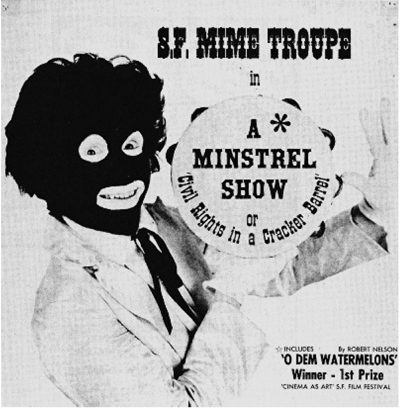 San Francisco Mime Troupe, The Minstrel Show — Or Civil Rights in a Cracker Barrel - including the film O Dem Watermelons - music by Steve Reich, 1965 Download program of The Minstrel Show (pdf) La composition de The Plastic Haircut sur un magnétophone mono Wallensack (l'un des premiers magnétophones commercialisé aux États-Unis et accessibles au public), utilisant des principes de boucles et de superpositions, utilisaient des sons enregistrés issus d'un disque intitulé The Greatest Moments in Sports (Columbia, 1955). Steve Reich explique en 1970 à Michael Nyman : « J'enregistrais un bout, puis stoppait le magnétophone, déplaçait l'aiguille du pick-up, et recommençait à enregistrer... il n'y avait pratiquement pas de collures ». Plastic Haircut débute par les sons une foule en liesse dans un grand stade animé par des fanfares jouant de la musique. Dès le début une sensation de chaos se met en place au fur et à mesure que le volume sonore de la foule croît en intensité. Une trentaine de secondes plus loin dans la pièce, comme si l'aiguille du pick-up se déplaçait sur un disque, on tombe sur une seconde ambiance : un match de boxe et nous entendons Jack Dempsey crier "vous allez l'obtenir si vous ne faites pas attention!" (you’re gonna get it if you don’t watch out!). L'auditeur est obligé de se demander qui Reich, par la voix de Dempsey, avise ici et alpague : les institutions politiques ? gouvernementales ? la société ? Chaque intervention vocale au long de cette pièce contient un message vindicatif relevant d'une certaine violence. Et la façon dont ces fragments sont assemblés et montés renforce cet sensation de violence et de rudesse. Nous entendons, "attention" (watch out), "coups de battes de base-ball" (beatings with baseball bats), "américain à sang chaud" (red-blooded American), "encore fait le même coup" (same old punch), "tabassé" (punched in succession). Ces phrases sonnent comme des descriptions de ce qui se passait dans les rues de la ville lors de manifestations et émeutes. "Américain à sang chaud" est particulière poignant : politiquement, la crise des missiles cubains de 1962 était encore très présente dans l'esprit des Américains, qui sentaient avec paranoïa que le monde pourrait finir avec la pression sur un bouton. Cette œuvre se termine par un assaut de sons en cut rapides et très forts de bruits de foule, qui semblent établir une sorte de mur de bruit. Il n'y a rien d'apaisant dans cette pièce : c'est violent, agressif et conflictuel comme était l'époque où cette œuvre a été composée. Livelihood (1964) est un collage sonore de trois minutes composé à partir de sons enregistrés et collectés, évoquant la vie quotidienne d'un conducteur de taxi (à l'époque Steve Reich conduisait un taxi pour vivre), du moment où le client énonce la destination, des amorces de conversations, et se terminant avec le paiement de la course, et avec 'Merci' et 'Bonne nuit' : conversations, claquements de portes, bruits de compteur, grognements et gémissements, des personnes qui s'énervent... bref, les bruits qu'on entend à l'intérieur d'un taxi... Steve Reich détruisit le master de cette pièce, ainsi que d'autres œuvres, au milieu des années 80. La même année il compose Music for Two or More Pianos (1964) où il expérimente les prémices du phasing posant ainsi les tout premiers jalons de ses techniques futures. C'est également à l'occasion des soirées musicales organisées par Reich sur Boccana Street avec cette troupe de mime (San Francisco Mime Troupe) qu'il fait la rencontre en mai 1964 de Terry Riley venu assister en voisin à l'une de ces soirées durant laquelle Reich présentait plusieurs œuvres : Proportional Piece #1, et deux improvisations à partir de son œuvre Pitch Charts (version live et avec bande) jouées par un sextet comprenant le saxophoniste Jon Gibson, le trompettiste Phil Lesh (qui deviendra le bassiste du groupe Grateful Dead), le claviériste Tom Constanten, le violiniste George Rey (qui sera connu plus tard en tant que philosophe), la violoncelliste Gwen Watson et Steve Reich. Riley et Reich s'aperçoivent alors de leurs intérêts communs et ce dernier se propose de faire partie de l'ensemble que Riley cherche avec difficulté à constituer pour l'exécution prochaine de sa toute nouvelle pièce. Le 4 novembre 1964, il participe en tant que pianiste, avec Jon Gibson (au saxophone) et sa petite amie de l'époque Jeannie Brechan (au piano électrique) qu'il a recrutés, à la création de In C, considérée comme l'œuvre fondatrice du courant minimaliste. C'est Reich qui suggère à Riley d'utiliser une pulsation rythmique marquée et régulière au piano pour In C. En retour l'influence de Riley sur les compositions à venir de Reich sera d'une importance majeure. Un peu plus tard en 1964, Steve Reich acquiert un magnétophone Sony 770, une machine à la pointe de son époque, et un magnétophone portable Uher - les deux en co-paiement avec Phil Lesh. Il brancha un microphone sur le Uher, de la taille d'une moitié d'un attaché case, niché sous le siège du chauffeur, et le micro, attaché au luminaire de l'habitacle de la voiture. Il put ainsi commencer à enregistrer des conversations dans un taxi. Cette technique d'utilisation de fragments de voix (par enregistrement et montage), déjà présente dans son premier collage sonore Plastic Haircut, anticipe les élaborations plus développées et complexes de répétitions et de boucles qui sont présentes dans son œuvre postérieure pour bande magnétique, It’s Gonna Rain (1965). Dans cette œuvre, Steve Reich emploiera pour la première fois cette technique de "phrasé" (mélodique, déphasé, superposé) en utilisant un enregistrement de la voix de Brother Walter, un prêcheur afro-américain pentecôtiste, délivrant un sermon dans le San Francisco’s Union Square. Au début de l'année 1965, Steve Reich utilise un fragment d'enregistrement de la fin de "Massa's in De Cold Cold Ground" (1852) de Stephan Foster et l'organise sous la forme d'un canon à 5 parties dans la musique qu'il réalise pour le film Oh Dem Watermelons qui sera montré dans le Mime Troupe's "minstrel show," un spectacle qui présentait des sortes d'illustrations outrancières des stéréotypes raciaux latents dans la société, "illustrations" implicites autant dans la musique que dans le spectacle lui-même. Le canon Oh Dem Watermelons composé par Reich et qui accompagnait dans des intermèdes du spectacle "minstrel show" la projection du film éponyme de Robert Nelson constitué de séquences en cut comprenant des pastèques volant dans les bras de Superman, qui étaient fracassées et explosées, puis caressées par une femme nue, etc. Click to enlarge 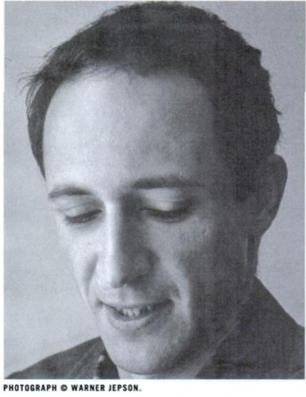 Steve Reich in 1965. |
| Some tape machines used by Steve Reich at that time / Quelques magnétophones utilisés par Steve Reich dans ces années-là | ||||||||||||
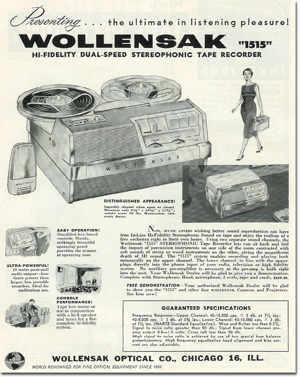 Wollensack, 1963 | 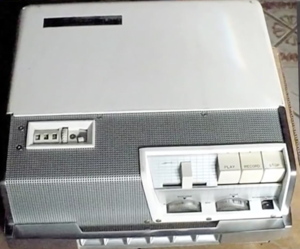 Wollensack, 1963 | 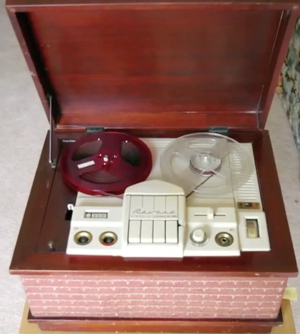 ? |
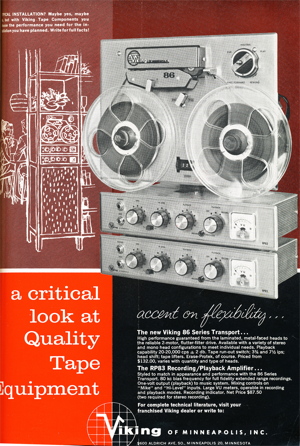 Viking mono, 1963 | 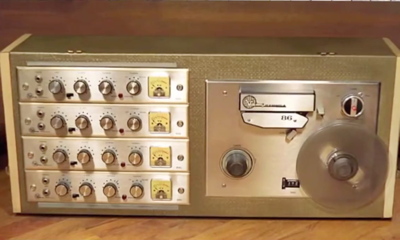 Viking, 1963 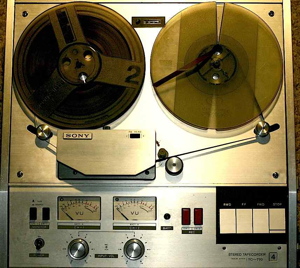 Sony 770, 1964 | 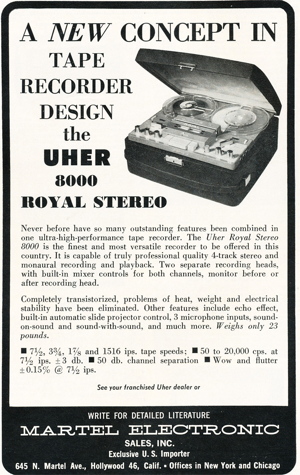 Uher, 1964 |
| Steve Reich & Terry Riley Click to enlarge 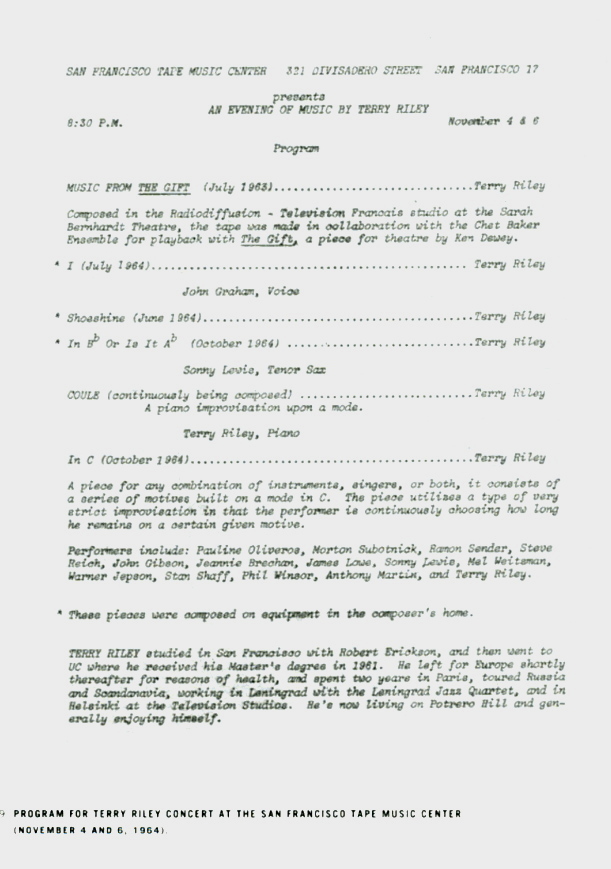 | Chronology 1963-1965 - San Francisco 1963 — R.G. Davis creates the film Plastic Haircut with Robert Nelson, Robert Hudson, and William Willey ; sound by Steve Reich. December 11, 1963 — The San Francisco Mime Troupe stages Ubu King, written by Alfred Jarry, sets, props & costumes by William Willey, music by Steve Reich, lighting designed by Jay Fox, directed by R.G. Davis. — [more info (sfmt.org)] — [programme (sfmt.org)] February 27, 1964 — The San Francisco Mime Troupe stages Event III (Coffee Break) at Capp Street Studios, including visual projections by Elias Romero, sound by Steve Reich and Phil Lesh, and movement by R.G. Davis and Fumi Spencer. — [more info (sfmt.org)] — [programme (sfmt.org)] May 21, 23, 29-30, 1964 — Steve Reich presents ‘Music Now Koncerts’ at the San Francisco Mime Troupe Theatre, including ensemble improvisations and compositions by Reich, Phil Lesh, Tom Constanten, and Jon Gibson. July 24, 1964 — The San Francisco Mime Troupe presents Molière’s Tartuffe, adapted by Richard Sassoon, with music by Steve Reich. — [more info (sfmt.org)] — [programme (sfmt.org)] January 27, 1965 — San Francisco Tape Music Center season concert ‘The Music of Steve Reich’ program includes : It’s Gonna Rain, or, Meet Brother Walter in Union Square after Listening to Terry Riley (1965), Music for Three or More Pianos or Piano and Tape (1964), and Livelihood (1964). April 12 and 15, 1965 — San Francisco Tape Music Center season concert program includes Bruno Maderna, Le Rire (1962) ; Steve Reich, Livelihood (1964) ; Earle Brown, Times Five (1963), for five instruments and two 2-channel tapes, featuring Jean Cunningham, flute, Stuart Dempster, trombone, Nathan Rubin, violin, Helen Stross, cello, and Ann Adams, harp ; and an Anthony Martin -Morton Subotnik - Ramon Sender collaborative event in seven sections, for piano, clarinet, tape, and visual projections, including I. UCLA, II. Improvisation, III. Objects, IV. Slide, V. Two Portraits JOHN, RICHARD, VI. Ninety Feet, VII. Improvisation. Summer 1965 — O Dem Watermelons, a film by Robert Nelson and music by Steve Reich, at the Commedia Theatre, Palo Alto. — [more info (sfmt.org)] September 1965 — Steve Reich moves to New York City. |
It's Gonna Rain (January 1965)(Edit)
| Steve Reich quotes William Carlos Williams : My poetry comes out of the American speech rhythm. Let me jump to a present reality : we live, in which we call America we call America, in a present world where we speak a language (the basis of the poem which we hear about us every day). It is not the English any longer if it was ever so [...]. It is our only language. By measure I mean musical pace. Now with music in our ears the words need only be taught to keep as distinguished an order, as chosen a character, as regular, according to the music, as in the best prose. By its music shall the best of modern verse be known and the resources of the music. The refinement of the poem, its subtletly, is not to be known by the elevation of the words but – the words don’t so much matter – by the resources of the music. — (William Carlos Williams) | Steve Reich citant William Carlos Williams : Ma poésie vient du rythme du parler américain. |
| — I grew up listening to Ella Fitzgerald. I think she was a model voice for me. — (Steve Reich in Alburger, "A Conversation," 6) | — "J'ai grandi en écoutant Ella Fitzgerald. Je crois bien qu'elle est pour moi un modèle vocal."— (Steve Reich in Alburger, "A Conversation," 6) |
| Before he left for New York, Reich created It’s Gonna Rain, which has been documented as his first “mature” composition. In fall 1964, Reich began a more important piece using voice. Tipped off by a friend, he brought the Uher and a shotgun mike to Union Square to record a young black street preacher named Brother Walter quoting Scripture and prophesying apocalypse in quasimusical declamation. After taping him, Reich’s problem was what to do with tape that could match the raw material itself. He considered collage and also attempted musical transcription of Brother Walter’s implied pitches — a technique he would not perfect until a quarter-century later in Different Trains. —— Tape loops were something I was fooling around with since about 1963. I was interested in real sounds, what was called musique concrete in those days, but I wasn't really interested in the pieces that had been done. I thought that they were boring, partly because the composers had tried to mask the real sounds. I was interested in using understandable sounds, so that the documentary aspect would be a part of the piece. And I think that It's Gonna Rain is an example of that, as is Come Out. It's Gonna Rain is a setting of a text about the end of the world. I recorded this incredible black preacher, whose name was Brother Walter. And I must say, I think It's Gonna Rain is a good setting of the Flood, though not a setting in any conventional way. I would describe It's Gonna Rain as a piece of vocal music, albeit obviously from an experimental standpoint and very much from the sixties. […] [I got the initial idea] when I was fooling around with tape loops of the preacher's voice, and still under the influence of In C. I was trying to make a certain relationship: I wanted to get "rain" on top of "it's," so that the net effect would be "rain, rain, rain, rain" coming out of one contrapuntal voice, while the other voice would be going "it's gonna, it's gonna, it's gonna." In the process of this, I put headphones on and noticed that the two tape recorders were almost exactly in sync. The effect of this aurally was that I heard the sound jockeying back and forth in my head between my left and right ear, as one machine or the other drifted ahead. Instead of immediately correcting that, I let it go ... took my hands off of it for a bit. What happened was that one of the machines was going slightly faster, and the sounds went over to the left side of my head, crawled down my leg, went across the floor, and then started to reverberate, because the left channel was moving ahead of the right channel. I let it go further, and it finally got to precisely the relationship I wanted to get to. But what I realized was that instead of making a particular canonic relationship, which was a momentary part of an overall composition, I had discovered a process which was a series of rhythmically flexible canons at the unison ... beginning and ending in rhythmic unison. This immediately struck me. It was an accidental discovery, but a lot of people could have heard that same phenomenon and said, "Line the machines up." It impressed me that I'd hit something that was more significant than what I was trying to do in the first place. Suddenly, I got the idea for making a tape piece that would be much more of a process. […] [During the first performance of It’s Gonna Rain] I didn't play the second half of it [Note : It’s Gonna Rain consists of two parts], so it wasn't perceived, obviously, for what it really was. I was feeling very disturbed at that stage in my life. The latter part of It's Gonna Rain seemed so paranoid and depressing that I suppressed it. But it's the second half which really sticks it to you technically and musically. After coming back to New York, and feeling somewhat less pressured, I listened to the second half and realized it was obviously part of the piece. Curiously enough, whenever I find people who like the piece, they have a similar attitude: it's very disturbing, but they really like it. You know, it's a heavy trip — bad vibes — but there's substance in there that gets to you. — (Steve Reich, In Talking Music by William Duckworth © 1995 by Schirmer Books ISBN 0-02-870823-7, pp. 293-7 — Source) | Ses premières œuvres pour bande s’inspirent de la musique concrète. Cependant, dans ses premiers collages (Plastic Haircut, Livelihood), Reich ne recherche pas à suspendre le caractère indiciel du son enregistré et à en masquer la source par divers traitements électroniques, mais utilise le médium dans sa supposée transparence sémiotique. —— Lorsque j’étais étudiant, dans les années 1950 et 1960, mon goût portait vers la musique concrète ; cependant, des musiciens comme Pierre Henry ou Pierre Schaeffer me semblaient faire fausse route. Prenez par exemple un bruit d’accident de voiture : ils ne pouvaient pas le laisser ainsi, il fallait le ralentir d’une octave, le jouer à l’envers, le mettre dans un modulateur en anneaux… Du coup, le son était étrange, abstrait. Absurde… Ce que je voulais, c’était travailler avec quelqu’un qui dit : « Il va pleuvoir ! » (It's Gonna Rain) Immédiatement, cette parole résonnait en moi : une voix réelle, appartenant à un être humain qui, par la musique, dépassait sa propre individualité. En plaçant ce matériau de base dans un contexte abstrait, celui de la composition musicale, on se faisait une idée de la personne et peut-être du contexte social et politique auquel elle appartenait. — (Steve Reich, Entretien accordé à Artpress, n°359, septembre 2009, p.30) |
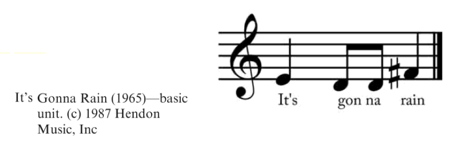 | Le compositeur fait ici référence à It’s Gonna Rain (1965), faisant usage de paroles humaines enregistrées mises en boucle et acte de naissance du « déphasage ». Cette technique de composition répétitive est née des limitations techniques du matériel électronique. Les magnétophones bon marché utilisés par le compositeur ne permettant pas une parfaire synchronisations des fragments enregistrés, il apparut que l’un des magnétophones « dérivait » par rapport au premier, donnant naissance à de complexes interactions rythmico-mélodiques que le compositeur explorera jusqu’au début des années 1970. La technique du déphasage sera appliquée à des microphones en mouvement suspendus au-dessus d’amplificateurs et de haut-parleurs (Pendulum Music, 1968) et, plus significativement, à l’écriture instrumentale (Reed Phase, Piano Phase, Violin Phase). |
|
It's Gonna Rain Part I — 0:00 It's Gonna Rain Part II — 7:59 |
Les premières œuvres de Steve Reich sont des sculptures d’une voix parlée captée par le magnétophone. Le compositeur travaille à un déplacement du discours oral vers le chant au prix de manipulations simplistes mais astucieuses qui transforment le matériau sémantique en matériau musical par un effacement progressif de la parole. Dans It’s Gonna Rain (1965), Steve Reich enregistre sur bande magnétique les prêches répétitifs du frère Walter, un jeune virtuose de la parole qui prêche le dimanche dans les jardins de l’Union Square, à San Francisco. "It’s gonna rain" réfère à l’épisode biblique de l’Arche de Noé. Il a commencé à pleuvoir et les gens se sont précipités vers l’Arche de Noé. Mais il est trop tard : Noé n’ouvre pas la porte à ceux qui n’ont pas cru la prédiction de Dieu. Dans le contexte de la guerre froide, "It’s gonna rain" pointe l’imminence d’un désastre nucléaire auquel la crise des missiles de Cuba semble devoir mener.
L’œuvre dure dix-sept minutes et trente et une secondes. Steve Reich a enregistré le prêche d’un après-midi de novembre. Il a copié cet enregistrement sur une seconde bande magnétique et, dans la première partie de l’œuvre, il se contente de passer la phrase éponyme en boucle sur deux magnétophones simultanément. Or, les magnétophones dont il dispose ne fonctionnent pas rigoureusement synchrones et il se produit, après plusieurs passages en boucle, un déphasage progressif entre les deux bandes. À mesure du déroulement de la séquence, nous perdons le fil du discours. Les mots du frère Walter peu à peu nous échappent. Selon les rapports de phases, nous entendons un [its] appuyé ou un [rein] chargé d’intensité dramatique. Et l’on oublie l’énoncé : notre attention est captée par le rythme syncopé que produit l’alternance des [its] et des [rein]. La parole a disparu, nous sommes entrés en musique. |
 Steve Reich As mentioned earlier, the Cuban Missile Crisis and the Cold War were still fresh in the minds of Americans in 1965. The conflict in Vietnam was escalating as well. It was not so far fetched to think that the end of the world is near. Reich himself mentions, "You’ve got to remember that the Cuban Missile Crisis happened in 1963, and it was still very much on everybody’s mind. It was clear that life hung by a thread and with one misstep—one miscalculated innuendo—we’d all be nuclear dust. And I was going through a divorce at the time. So put that all together in in a jug and shake and, well, you get a piece about the end of the world" (Steve Reich, In Zuckerman, 2002). It’s Gonna Rain is clearly a metaphor for a nuclear holocaust. At the time of the recording of It's Gonna Rain, the United States was in civil unrest and Reich seemed lost, still trying to find his way. The composition is broken up into two parts, the first of which was presented at the San Francisco Tape Music Center in January, 1965. The second section of the piece takes the intensity of the first part to another level, so much so that he did not subject the concert goers to it during the presentation of the piece at the San Francisco Tape Center. He saved the second part for a New York City performance, where he headed shortly after the completion of It’s Gonna Rain. Reich mentions in interviews that he felt disconnected from the hippy scene, which was beginning to take over in San Francisco. Reich decided to move to New York City in hopes of finding more work as a composer and starting fresh, only to feel disconnected once he arrived. | Mais une seconde partie suit, pour laquelle Steve Reich a répété cinq fois l’opération d’enregistrement de déphasages. Il a enregistré un autre passage du prêche et le passe en boucle sur deux magnétophones distincts (bandes 1 et 2). Il enregistre le déphasage produit, réalisant ainsi un premier mixage (bande 3), où l’on entend deux voix. Il répète l’opération et produit ainsi un second mixage (bande 4). Puis il mixe les deux pistes (3 et 4), de sorte que ce ne sont plus deux mais quatre voix que l’on entend sur cette bande magnétique (5). Il répète l’opération sur une autre bande (6) et mixe enfin les bandes 5 et 6, de quatre voix chacune. Au total, ce sont donc huit voix déphasées que l’on entend dans des registres de temporalités et de hauteurs distincts qui créent un chaos intense sans que l’on soit maintenant en mesure d’identifier chacune des voix tant les déphasages ont gagné en ampleur. L’écoute s’en trouve modifiée. Elle n’est plus centrée sur les mots du discours, mais sur les échos, sur les redondances, puis sur les seules intonations, jusqu’à ce moment où, renonçant à l’énoncé, nous lâchons prise et nous nous laissons happer par la voix seule, la voix travaillée, sculptée par le magnétophone et les déphasages successifs qui nous contraignent à adopter une écoute musicienne. Nous avons quitté le registre du prêche pour celui de l’œuvre musicale. Nous avons quitté le registre de la parole, en tant qu’elle est une expression verbale de la pensée, pour celui de la voix. Steve Reich érige alors ce bricolage en un procédé qu’il nommera phasing ( « délai de phases » ou « déphasage »). — [Laborde Denis, « Sculpter la voix, décentrer l'écoute : l'opéra selon Steve Reich », Le français aujourd'hui 3/2005 (n° 150) , p. 93-101] Terry Riley à propos de It’s Gonna Rain : « Il me joua des fragments [d’enregistrement de Frère Walter], puis il commença à en faire une pièce. La première chose qu’il essaya, avant d’entendre ce que je faisais, fut une sorte de collage. Ce qui est drôle, c’est que quand vous écoutez Frère Walter et entendez “It’s gonna rain ! It’s gonna rain !“, cela ressemble aux deux premières notes de In C. C’est un do et un mi. Je ne sais pas si c’est un do et un mi mais c’est une tierce majeure » [en fait ré et fa dièse]. — (Source : STRICKLAND Edward, American composers. Dialogues on Contemporary Music, Indiana University Press, 1991, p.11) |
Oh Dem Watermelons (1965)(Edit)
| Watermelons was commissioned by the San Francisco Mime Troupe as a short entertainment to be screened during intermission for its rather infamous 1965 Minstrel Show (Civil Rights from the Cracker Barrel), which assaulted racial stereotypes by wildly exaggerating them — as performed by (mostly white) performers in blackface, yet. The purpose of this film was to mock the racism that was running rampant in America. Many did not want to confront this fact. In America, the establishment would rather bury these accusations of racism, than have to confront them through music, theater or art. After all was said and done, the short film gained praise by film critics and is still hailed as a great achievement in underground film. A relative latecomer to filmmaking, the 35-year-old Nelson had just begun fooling around with the medium, mostly in collaboration with then-wife Gunvor Nelson. To make Watermelons he drafted talent from the Mime Troupe and alma mater Mills College, where he'd also found a young composer named Steve Reich, later known (to his occasional annoyance) as the father of minimalism, and thus the person to be blessed or blamed for subsequent fellow travelers Philip Glass and John Adams. Reich's raucously repetitive choral arrangement of a Stephen Foster oldie (Massa's in De Cold Cold Ground) (in which a slave mourns his deceased master) adds another satirical dimension to the color visuals, which direct the campus era's mood of anarchy and impudence toward the watermelon. Aiming to explode stereotypes and their symbols, the film finds melons used as bombs, footballs, baseballs, shooting targets, even as sensuous love objects. Watermelons are cut-and-pasted onto existing images (from Superman to a NASA missle) and sometimes animated there, à la Terry Gilliam's Monty Python 'toons. Fruits are chased by white male hordes, then turn around (via the magic of reverse projection) to chase them in return. | Le film Watermelons a été commandé par le San Francisco Mime Troupe en tant que court divertissement qui était projeté durant les entractes pour le spectacle plutôt infâme Minstrel Show (Civil Rights from the Cracker Barrel) de 1965 qui était une satire très exagérée des stéréotypes raciaux — comme par exemple le fait que les performeurs (majoritairement des blancs) se grimaient la face en noir. Le propos de ce film est une satire du racisme rampant aux États-Unis. La majorité des américains ne veulent pas reconnaître ce fait. Aux États-Unis, l’institution préférerait enterrer les accusations de racisme plutôt que de s’y confronter, même au travers de la musique, du théâtre ou de l’art. Ce court-métrage a gagné les éloges des critiques de cinéma et est toujours salué comme un grand succès dans le cinéma underground. Un tardif à la pratique du cinéma, Nelson, 35 ans, venait de commencer à s'amuser avec ce medium, la plupart du temps en collaboration avec son épouse d'alors Gunvor Nelson. Pour réaliser Watermelons il a tiré au mieux les talents présents dans la Mime Troupe et dans la pépinière du Mills College, où il avait également trouvé un jeune compositeur du nom de Steve Reich. Un arrangement choral plutôt bruyant et répétitif de Steve Reich basé sur un ancien hymne de Stephen Foster, Massa's in De Cold Cold Ground (dans lequel un esclave pleure son maître défunt) ajoute une autre dimension satirique aux visuels colorés, qui transpire l'humeur anarchique et impudente du campus à cette époque de la "pastèque". Visant à exploser les stéréotypes et leurs symboles, le film montre des melons utilisés comme bombes, ballons de football, de baseball, cibles de tir, même des love toys très sensuels. Des "pastèques" sont découpées et collées sur des images existantes (de Superman à un missile NASA) et parfois sont animées comme les toons de Terry Gilliam dans Monty Python. Les fruits sont chassés par des hordes de mâles blancs, puis les premiers tournent autour des seconds (via la magie de la projection inverse) pour les chasser en retour. |
——Other sources / Autres références :
——— http://www.ubu.com/sound/reich.html
Come Out (April 1966)(Edit)
|
Composed in 1966, it was originally part of a benefit presented at Town Hall , for the retrial with lawyers of their own choosing, of the six bots arrested for murder during the Harlem riots of 1964. The voice is that if Daniel Hamm, now acquitted and then 19, describing a beating he took in Harlem's 28th precinct. The police were only taking those that were visibly bleeding to the hospital, since Daniel Hamm had no bleeding he proceeded to squeeze open a bruise on his leg. "I had to like open the bruise up and let some of the bruise blood come out to show them." — (Source (YouTube comments)) |
Steve Reich explore à nouveau ce procédé de phasing dans Come out (1966) en répétant une seule phrase pendant douze minutes trois quarts : « Come out to show them ». Il procède à nouveau par enregistrements successifs sur deux canaux qui produisent des déphasages, en retardant au moyen du pouce le déroulement de la boucle.
L’expérience d’audition est étrange : à mesure du déphasage, les cinq mots monosyllabiques paraissent plus nettement des notes : mi-bémol, do, do, ré, do. Steve Reich a modifié notre régime d’écoute. Il nous a transportés dans un univers musical où le bruit des paroles importe plus que les paroles. Les chuintantes de [?ou] s’installent. Travaillées encore par le jeu du déphasage, elles deviennent des sifflantes rythmant peu à peu la séquence à la manière d’une cymbale. La voix se fait section rythmique de jazz. Steve Reich appliquera également ce procédé aux instruments acoustiques. Dans Piano Phase (1995), il appliquera la technique des motifs résultants à un large ensemble – c’est la grande pièce à la composition de laquelle il se lance à son retour du Ghana, Drumming (1971) –, avant de s’en inspirer pour les trois voix de femmes de Tehillim (1981). — [Laborde Denis, « Sculpter la voix, décentrer l'écoute : l'opéra selon Steve Reich », Le français aujourd'hui 3/2005 (n° 150) , p. 93-101] |
Upon arriving in New York City, Reich realized he was once again disconnected, not from the hippy culture, but from the schools of music that were divided between the uptown and downtown areas of Manhattan. Uptown, where the bourgeoisie settled, the Serialists were composing and performing in concert halls conducive to classical music. The experimentalists and Cage’s circle were located in downtown Manhattan. Reich did not feel comfortable with either of these schools and settled in Tribeca and befriended painters, sculpture and choreographers. This is important when thinking of the social influences on his works. He was performing in art galleries and lofts as opposed to theaters or concert halls. His performances were on the bill with art installations and dance. Michael Snow, Richard Serra and Sol LeWitt were extremely influential on Reich’s work in New York City. They all had connections with the galleries, museums and lofts Reich performed at through the sixties. It was only natural that Reich’s association with these Minimalist artists led the music critics to tag Reich with term first used by writer/composer, Michael Nyman in a musical context, Minimalist. The performances of Reich’s works along with his phase and conceptual pieces that followed were all in direct opposition to the Uptown Serialists and bourgeoisie. The Civil Rights Movement was in full swing in ’64 and ’65, which saw the escalation of violence in the major US cities. During this period rioting was becoming commonplace. The Watts Riot and Harlem Riot only exacerbated the civil unrest in America. Reich’s first commissioned piece in New York City was directly related to the Civil Rights Movement and the Harlem Riot. | À son arrivée à New York, Steve Reich se rend compte qu'il était là aussi déconnecté, pas de la culture hippie, comme il l'avait senti en quittant la Californie, mais là des écoles de musique et conservatoires qui étaient divisés géographiquement entre uptown et downtown Manhattan. Uptown, où la bourgeoisie est installée, les musiciens du sérialisme étaient présents, composant et jouant dans les salles de concert réservées à la musique classique. Les musiciens de musique expérimentale autour de John Cage étaient plutôt dans downtown Manhattan. Reich ne s'est jamais senti à l'aise avec l'une ou l'autre de ces "écoles" et il s'est installé dans Tribeca et fréquentait plutôt les artistes peintres, sculpteurs et danseurs. Ce point est important si on veut penser les influences sur son travail. Il a ainsi réalisé des performances dans les galeries et dans des lofts au lieu de chercher à jouer dans les salles de concert ou de théâtre. Ses performances et concerts se sont retrouvés dans des programmes et des événements comprenant aussi des installations artistiques et des productions de danse. Des artistes comme Michael Snow, Richard Serra et Sol LeWitt ont été très influents sur le travail de Steve Reich à New York. Ils avaient tous des connexions avec les différentes galeries, musées et lofts dans lesquels Steve Reich a réalisé la création de ses œuvres durant les années 60. Il était donc en quelque sorte naturel que le travail de Steve Reich soit très vite associé, par les critiques et journalistes musicaux, avec le minimalisme ou l'art minimal à cause de cette proximité avec ces artistes. C'est ainsi qu'un des premiers à faire cette association a été le compositeur et critique Michael Nyman en parlant de Minimalisme (en musique) et d'un contexte minimaliste. Les créations des œuvres de Steve Reich durant cette période où il développe ses pièces conceptuelles et liées au "phasing" se présentaient comme étant antagonistes du sérialisme et de l'art bourgeois, tout comme on peut dire qu'elles se démarquaient du cercle cagien. Le Mouvement des Droits Civiques battait son plein aux États-Unis dans les années 1964 et 1965, qui ont vu l'escalade de la violence dans les plus grandes villes américaines. Durant cette période les émeutes étaient de plus en plus courantes. Les émeutes de Watts et d'Harlem ont exacerbé ces troubles civils aux USA. La première commande d'œuvre que Steve Reich a décroché à New York a été pour une oeuvre directement liée au mouvement pour les droits civiques et à l'émeute d'Harlem. | |||||||||
Blood and Echoes: The Story of Come Out, Steve Reich’s Civil Rights Era Masterpiece by Andy Beta Pitchfork magazine, April 28 2016 — Source (Pitchfork) On a spring day in 1964, police in Harlem’s 32nd precinct tried to beat a confession out of two black teenagers for a crime they did not commit. The young men, Wallace Baker and Daniel Hamm, were repeatedly bludgeoned with billy clubs while in custody, beaten with such force that they were taken to a nearby hospital for X-rays. In an interview at the nearby Friendship Baptist Church a few days after the incident, the 18-year-old Hamm recounted being brutalized in shifts by six to 12 officers over the course of the night, along with the fact that “they got so tired beating us they just came in and started spitting on us.” But even after hours of abuse, the cops weren’t about to allow Hamm to be admitted for treatment, since he was not visibly bleeding. Thinking fast, Hamm reached down to one of the swollen knots on his legs where the blood had clotted beneath his skin: "I had to, like, open the bruise up, and let some of the bruise blood come out to show them.” Those 20 words, spoken by a young man who would unjustly remain in prison for nine years, still land like a truncheon. And utilizing just that one sentence, composer Steve Reich made one of the most visceral pieces of music of the 20th century. The incident that led to Hamm’s bruises and blood began with the most innocent of acts: a capsized fruit cart, and a group of Harlem school children who began to throw the fallen grapefruits around like baseballs. But when the shop’s owner whistled for them to stop, it alerted the local police, who reportedly descended upon the kids with a viciousness that frightened all passersby. It was then that Hamm and Baker stepped between the children and the cops, attempting to defuse the situation. “I saw this policeman with his gun out and with his billy in his hand,” Hamm recounted. “I like put myself in the way to keep him from shooting the kids. Because first of all he was shaking like a leaf and jumping all over the place. And I thought he might shoot one of them.” And while Hamm’s bloodletting did allow him to get medical attention and be released, his freedom was short-lived. Ten days later, on April 30, the stabbing death of Margit Sugar at her used-clothing store in Harlem brought the police back to the teenager’s door. Along with Hamm, they rounded up five other teens: Baker, Walter Thomas, William Craig, Ronald Felder, and Robert Rice. Despite a paucity of evidence and the prosecution's star witness being the one most likely to have actually committed the crime, this group—deemed the “Harlem Six”—was charged with murder, for which the penalty in New York State was death by electric chair. Hamm and the others would remain incarcerated for the next nine years. Soon, the news media distorted their case even further, with The New York Times portraying the Six as members of an anti-white gang called the Blood Brothers. The NAACP insisted that no civil liberties had been violated in the case, but as summer progressed, another instance of police violence—the shooting death of James Powell, a 15-year-old black boy—led to roiling riots in Harlem and Brooklyn’s Bedford-Stuyvesant neighborhood, precipitating further unrest in Philadelphia, Chicago, Rochester, and throughout New Jersey. Over the next four years, race riots would rage from Watts in Los Angeles, to Detroit and Washington, D.C. Truman Nelson, a civil rights activist, recorded interviews with the boys as well as their mothers and put them together into a book entitled The Torture of Mothers in order to raise awareness about their case. In an effort to raise money to cover legal fees for a retrial, Nelson set about organizing a benefit concert in 1966. In addition to protest songs and speeches from supporters, Nelson wanted to have his interview tapes edited to tell the story of the Harlem Six. “I got a call from Truman Nelson saying: ‘I heard that you work with tape,’” Steve Reich tells. “I thought, I'm not a tape editor, but yeah, I've worked with it.” Reich had realized his first tape piece the year before, based on a recording he made of San Francisco Pentecostal street preacher Brother Walter talking about Noah and the great flood. Walter proclaimed: “It’s gonna rain.” By 1966, Reich had returned to his home of New York City and was situated in a studio downtown when he first met Truman Nelson. At that point, Reich was unfamiliar with the trial and events surrounding the Harlem Six. The burgeoning civil rights movement was one of the biggest concerns of the day, yet Reich in some way felt on the outside of the situation. “I wasn't doing anything about it really,” he admits. But he agreed to edit together Nelson’s 20 hours of analog interview tapes into a coherent narrative pro bono, under one condition: permission to make a piece along the same lines of It’s Gonna Rain if he found the right phrase. Nelson agreed. Steve Reich: “And then, on the strength of that piece (It’s Gonna Rain), I was asked to do a piece as part of a benefit for the retrial of the six black kids who’d been arrested for murder in 1966, who were referred to as the Harlem Six. Now, there was a murder committed, but one of them did it — not all six. This kid, Daniel Hamm — whose voice I was using — did not do it and was acquitted. I was given a stack of about ten reels of tape with mothers and voices, and I said to the guy —Truman Nelson was his name — who was a civil rights person and scholar of John Brown, I said, ‘Look, I’ll do this and I’ll do it for nothing, but you’ve got to let me make a piece out of anything I find.’ He said, ‘What do you mean by a ‘piece’?’ So I played him It’s Gonna Rain, and he was just strange enough to say ‘Hey! That’s great! Good! You want to do that? Go ahead!’” — (An Interview with Steve Reich by Gabrielle Zuckerman, American Public Media, July 2002) [Source — Mike Hoolboom - Measuring Steve Reich (February 2016)] The composer says he was looking “to find the key phrase, the exact wording of which would sum up the whole situation… and the tone of Hamm’s voice, the speech melody, and what he says encapsulated a lot of what was going on in the civil rights movement at that time.” Reich hums the line’s cadence over the phone. “When I heard that, I thought, This is going to make a really, really, really interesting piece.”  Reich took this eight-second phrase and looped it, later dividing the tape into eight frenzied voices. The composition opens with Hamm’s statement repeated three times before the two tape loops begin to move out of phase with each other. That subtle shift at first gives Hamm’s voice a slight echo and, by the three-minute mark, the words are swathed in reverb as the voices move out of synch. As the loops build, Hamm’s concrete imagery transforms into something hazy and unrecognizable as speech. For all of its subsequent influence, Come Out had an inconspicuous, even subliminal debut that April night at Manhattan’s Town Hall. The benefit, hosted by the Charter Group for the Harlem Six, featured protest songs, dramatizations from The Torture of Mothers, Reich’s commissioned audio narrative, and a speech by Ossie Davis, who had delivered the eulogy for Malcolm X the year before. Attendees would be hard-pressed to recall Come Out, though, and it received no notice or reviews in the press. “The world premiere of Come Out was as pass-the-hat music,” Reich says with a laugh. Was there a reaction from the crowd ? “Yeah, people were reaching in their pockets! I don't think people paid a great deal of attention to the music. They just thought it was some kind of funny sound effect that was atmospheric to get them to contribute. It wasn't a concert situation at all!” Funds raised at the event allowed the Harlem Six and their families to pay for civil rights lawyer Conrad Lynn and other legal fees. Their case went to appeals in 1968, but retrials and three hung juries stretched the proceedings to 1973. After being held without bail for nine years, they finally plead to manslaughter in exchange for suspended sentences. Daniel Hamm was released the following year and has since avoided the public record. While a touchstone in the fight for civil rights, the case of the Harlem Six has almost vanished from popular culture as well. But Come Out continues to loop. In a 2009 essay, music academic Sumanth Gopinath wrote: "In retrospect, [Come Out] served as the most prominent historical memorial for the legal and political drama known as the Harlem Six case." Come out was performed at Town Hall in April of 1966 and raised enough money for the Harlem Six to obtain counsel of their choice for the retrial as opposed to the often inept council appointed by the courts. The month after Come Out’s low-key premiere, Reich performed at the Park Place Gallery in SoHo, a venue where his tape pieces were presented so that they closely aligned with minimalist art and sculpture. The show was reviewed in the Village Voice, which cited Come Out and noted: “Mr. Reich’s strident, reiterative work… suggested a raga exercise, distorting and distorting to incandescence.” In 1967, Come Out was recorded and released on CBS-Odyssey’s “Music of Our Time” record series, alongside titans of modern composition including John Cage, Karlheinz Stockhausen, Pierre Boulez, Morton Feldman, and Terry Riley. “Come Out was the end of my working with tape, but it was the start of my taking the principle of phasing discovered with it and applying it to live musicians,” Reich says. “It was beginning of a highway, really, to the music of the rest of my life… the end of something and the beginning of something, simultaneously.” 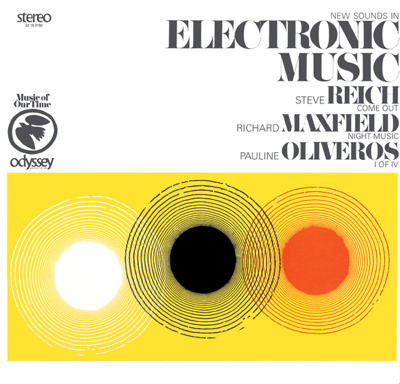 I first made a loop of the phrase ‘Come out to show them’, and recorded a whole reel of that on channel 1 of a second tape recorder. I then started recording the loop on channel 2 ; after lining up the two tracks, with my thumb on the supply reel of the recording machine, I very gradually held it back (I was literally slowing it down, but at such an imperceptible rate that you can’t hear) until ‘Come out to show them’ had separated into ‘come out-come out / show them-show them’ (which is something like two quavers away). At that point I take that two-channel relationship, make a loop from it, feed it into channel 1 again, hold it back with my thumb so that it is four quavers away from the original sound and can be heard as a series of equal beats, so that it is quite distinct melodically. I then spliced together the two-voice tape with the four-voice tape — they fit exactly — and what you sense at this point is a slight timbral difference, due to all this addition, and then all of a sudden a movement in space. At that point I then divided it again into eight voices, separated it by just a demisemiquaver, so that the whole thing, began to shake, then just faded it out and again put those two takes together. So there’s absolutely no manipulation of the timbre, no manipulation of the tape. — (Steve Reich, in An interview with Michael Nyman, The Musical Times, Vol. 112, No. 1537 (Mar., 1971), pp. 229-231) |  A man is beaten by police during the Harlem riot of 1964. Photo by Buyenlarge/ Getty Images. En 1966, Steve Reich compose, sur commande, une pièce en soutien aux « Harlem Six », un groupe de six jeunes afro-américains arrêtés et inculpés collectivement pour un meurtre commis lors des émeutes de Harlem de 1964. L'ensemble du groupe fut jugé coupable et battu par la police, alors que seul l'un d'entre eux était l'auteur du crime. Truman Nelson, un militant du mouvement des droits civiques, confie à Steve Reich dix heures d'enregistrements des témoignages de jeunes gens, le laissant libre de les utiliser à sa guise comme source de création musicale primaire. La pièce est ainsi basée sur la phrase « I had to, like, open the bruise up and let some of the bruise blood come out to show them ». — — « J’ai dû ouvrir ma blessure et en faire sortir du sang pour leur montrer. » Cette phrase prononcée par Daniel Hamm, un des garçons impliqués dans les violences mais innocent du meurtre dont il était accusé fait référence au fait qu'il ait dû faire saigner ses bleus pour convaincre de l'importance de ses blessures, et à l’absence de soins prodigués au jeune homme par la police. Come Out, en 1966, toujours pour bande, reprend donc directement le principe de la deuxième partie de It’s Gonna Rain, mais de manière beaucoup plus rigoureuse et efficace. L’enregistrement est celui de Daniel Hamm, jeune noir molesté par des policiers à la suite d’une manifestation. Afin d’être emmené à l’hôpital et échapper au poste de police, Hamm se comprime volontairement une contusion: « I had to like open the bruise up and let some of the bruise blood come out to show them » (« J'ai dû, donc, ouvrir ma blessure et laisser le sang couler des ecchymoses pour leur montrer. » — traduction alternative). Le son est beaucoup plus propre que dans l’enregistrement de Frère Walter, ce qui augmente la pertinence du passage global du « son » au « bruit ». De plus, la courte boucle utilisée, « come out to show them » est fortement rythmée : elle contient même en son sein une périodicité rythmique née des deux consonnes accentuées (voir exemple ci-dessous). Ce motif est très proche des motifs mélodico-rythmiques qu’on trouve dans les œuvres postérieures de Reich. Sa carrure rythmique est un atout essentiel pour l’intérêt du processus, car des motifs rythmiques résultants apparaissent aux divers moments de synchronisation des doubles croches, et une périodicité rythmique marque certains moments comme la moitié, le quart, ou le huitième du cycle complet de déphasage, moments que Steve Reich choisit précisément comme points de montage. On peut suivre sur l’exemple 1 (ci-dessous) la description formelle de l’œuvre. La troisième portée de chaque système indique le rythme résultant des divers emplacements de la consonne « sh », consonne la plus bruitée des deux consonnes accentuées. Du fait des superpositions rythmiques, du fait du choix du moment des points de montage, la présence de ce phonème augmente peu à peu, mais non régulièrement, jusqu’à un état de saturation où toutes les doubles croches sont occupées. Cet état de saturation rythmique et sonore, où toutes les syllabes de la boucle initiale se superposent en continu, détermine la fin du processus de transformation globale de l’œuvre, passage de l’articulé au saturé, du rythmique à l’arythmique, du sonore au bruité, du sémantique au phonétique. Come Out dure moins de treize minutes : cette œuvre ne saurait être considérée comme une toile de fond sonore, mais est conçue pour être écoutée attentivement, afin d’en percevoir le cheminement temporel, ainsi que les divers détails comme les motifs résultants. En dehors de ses qualités émotionnelles et purement sonores, elle constitue une des premières et des plus pures manifestations d’un système musical fondé sur la transformation processuelle. — [Jérôme Baillet, Flèche du temps et processus dans les musiques après 1965] 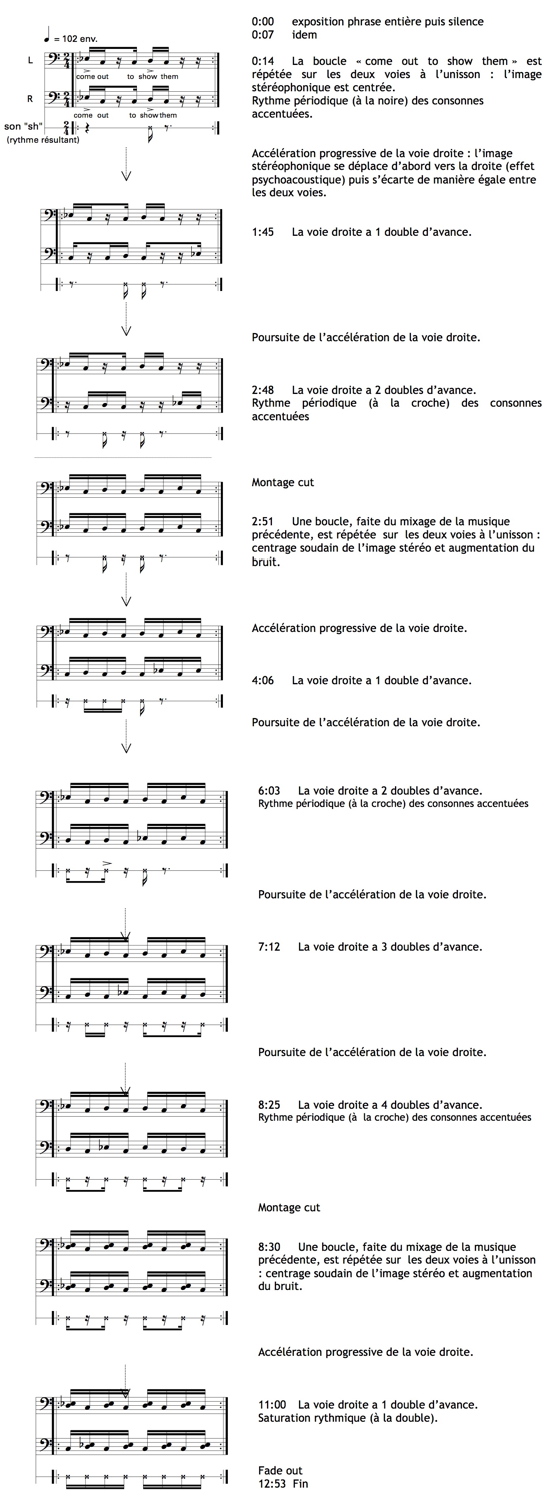 [analyse musicale de Jérôme Baillet, In "Flèche du temps et processus dans les musiques après 1965"] 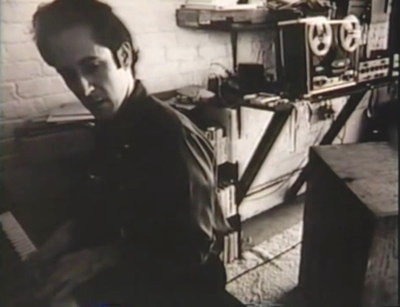 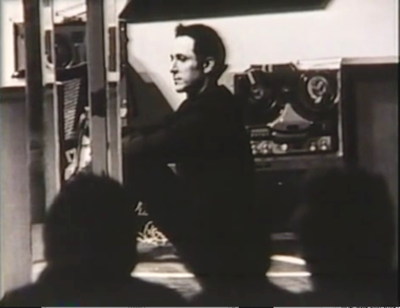 — — "J’ai d’abord fait sur un magnétophone une boucle avec la bande magnétique de la phrase ‘Come out to show them’ et j’ai enregistré le résultat sur le canal 1 (droit) d’un second magnétophone. J’ai enregistré ensuite la même boucle sur le canal 2 (gauche) [en dubbing]: après avoir aligné les deux pistes, je retenais progressivement avec mon pouce la bobine droite du magnétophone (c’était littéralement ralentir la vitesse, mais à un tel niveau imperceptible qu’il était difficile de le percevoir) jusqu’à ce que la phrase ‘Come out to show them’ se décale peu à peu et devienne ‘come out-come out / show them-show them’ (ce qui correspond à peu près à un décalage de deux croches). À partir de ce moment-là, j’ai pris [enregistré] ce résultat comprenant le décalage progressif entre les deux pistes, fait une seconde boucle avec, ré-enregistré sur le canal 1 du magnétophone enregistreur, et ralentit une nouvelle fois, aussi avec mon pouce sur la bobine, et ainsi j’ai réalisé cette fois-ci un déphasage de quatre croches par rapport à l’enregistrement d’origine, qui pourrait être entendu comme une série de battements égaux ou équivalents, ce qui crée une distinction mélodique claire. J’ai ensuite assemblé ensemble les deux enregistrements stéréo sur un magnétophone quatre pistes — leurs longueurs et durées correspondaient exactement — et ce qui était perçu à ce stade c’est une légère différence timbrale due à la superposition des déphasages et ralentissements jusqu’à créer tout-à-coup une sorte de mouvement spatial. J’ai ensuite réitéré les mêmes opérations jusqu’à obtenir huit pistes, juste décalées d’une triple croche, ce qui a fait apparaître des légers battements, et j’ai fait des fade-out sur les fins de bande, et une nouvelle fois j’ai assemblé les prises ensemble. Donc il n’y a absolument aucune manipulation du timbre, ni de manipulation de bande." — (Steve Reich, in An interview with Michael Nyman, The Musical Times, Vol. 112, No. 1537 (Mar., 1971), pp. 229-231) | |||||||||
When listening to Plastic Haircut, Livelihood, It’s Gonna Rain and Come Out we one can hear not only the development of a young artist, but we also get a glimpse inside America in the 1960’s : the assassinations of President Kennedy and Martin Luther King, jr., the Cold War and the Cuban Missile Crisis, the Civil Rights Act of 1964 and the Vietnam War, etc. The counter-culture was pushing for a multi-cultural society. All of these socio-political factors are embedded in the early works of Steve Reich. They directly influenced his compositions, his psychology and his development as an artist. — (according to Gregg Kowalsky, A Socio-Political Analysis of Steve Reich’s Early Compositions (1963-1966), 1964) | Lorsqu'on écoute les œuvres telles que Plastic Haircut, Livelihood, It’s Gonna Rain et Come Out, on peut percevoir non seulement le développement progressif du travail d'un jeune artiste, mais aussi avoir un aperçu de la société américaine dans les années 60 : les assassinats du Président Kennedy et de Martin Luther King jr., la Guerre Froide et la Crise des missiles cubains, la loi des droits civiques de 1964, la Guerre du Vietnam, etc. La contre-culture poussait, de son côté, vers une société multi-culturelle. Tous ces facteurs socio-politiques sont présents et intégrés dans les œuvres de cette première période de Steve Reich. Ils influencent directement ses compositions, tout autant que sa psychologie et son développement artistique. — (according to Gregg Kowalsky, A Socio-Political Analysis of Steve Reich’s Early Compositions (1963-1966), 1964) |
Electronic Music, Visual Arts, Inter-Media(Edit)
In the 1960s San Francisco milieu, a route evolved in the genealogy of electronic music and its unique intersections with the visual arts — Concretizing sound completely transformed the way art considers its objects. Interestingly, the expansion of sculpture into spatial installations transpires in tandem with the advancements made in the recording of music. These passages not only merged corporeal performance, instrumental music, and electronics, but also changed sensual perception and the role of the senses in making new spatial and temporal propositions. Sense set as pregiven topographies gave way to making sensuous topologies in the praxis. Set topographies oscillated between a forgetting of ground and anticipation and the blinded expansion of gradual processes enabled other, “lower” senses to play a central role in perception and production. In the realm of the sonorous, the production of new sonic spaces was contingent on active hearing. At the time, the San Francisco art scene included multiple experiments with music, sound, film, and choreography. The return to the body was not restricted to some philosophical or musical academic discourse, but was imbued with a west coast stance on international politics. From the civil-liberties activists to the Berkeley Free Speech Movement, changing the rules meant rejection of the long traditions of proper and rational dictums. Reich crossed paths with this anarchic anticipation. Provoked by the crisis of war, the protests for human rights, and the Berkeley Riots, the Bay Area was imbued with antiauthoritarian activities that ranged from untying the rule of politics to forgetting traditional artistic means and searching for new ways of expression. The desire to do away with the old ordering principles was expressed in the investigation of language, whether through linguistics (mute sign systems), through phonology (spoken sounds), through the body (choreography), etc.), or through and its dispersion. While working against sign systems, artists sought to release the body from its epistemological restraints. The question at hand was not how the discourse of the body is constituted but how the body constitutes discourse and the possibility of an ethical discourse. Trapped by the sign and by sense, the body reproduced by language was understood as destined to be an object of knowledge, rather than a singular unique alterity, which may be presented by being in the proximity of other bodies—that is, a tangible body being-with others, always exposed, affected, and touched. Placing the body center stage was essential to the work of choreographer Anna Halprin, who founded the San Francisco Dancers’ Workshop in 1959 together with Simone Forti, Robert Morris, Trisha Brown, Yvonne Rainer, and John Cage. The Bay area’s counterculture scene, as it was later labeled, engaged in inter-media collaborations epitomized by the political satire of the San Francisco Mime Troupe, also founded in 1959 by R. G. Davis. Adding to this cultural expression of the body were the sonic spaces of the non-musical sound productions of Musique Concrète performed at the San Francisco Tape Music Center (SFTMC), established in 1962 by Morton Subotnik and Ramon Sender. The center also included Pauline Oliveros, Terry Riley, William Maginnis, and Tony Martin. Using the body as a producer of sound in the gallery space rejected problems of objecthood and consumerism, however, it also allowed untying the body from systems of signification by considering performance not as exposition (or exhibition) but as experimentation that yielded results predicated on the contingent conditions and relations uniquely set in each situation. Such experiments set anew political propositions without interest or intention. Reich gravitated towards the artists’ communities and began collaborating with artists in film, sound, and performance. The vibrant cross-pollination between the visual arts and music encouraged Reich to get involved in performance and underground films (similarly to Bruce Nauman). Reich began collaborating with Robert Nelson, Robert Hudson, and William T. Wiley. These collaborations proved useful in creating new communities, providing a place for political discourse, and allowing the artists involved to take part in decentralized settings. Both Reich’s and Nauman’s return to the body resists signification while working within the limits of language as well as the mechanics of the body, its capacities, abilities, and its exhaustion. — (Adi Louria-Hayon, FOLDING SPACES AND POROUS BODIES : SOUND AND SIGHT IN BRUCE NAUMAN’S OEUVRE, A thesis submitted in conformity with the requirements for the degree of Doctor of Philosophy Graduate Department of Art University of Toronto, 2013, pp 185-189.) | Dans le milieu californien (San Francisco) des années 60, des fils parcourent la généalogie de la musique électronique et ses intersections exceptionnelles avec les arts visuels. Travailler concrètement le son a transformé complètement la façon dont l’art envisage ses objets [et dont il permet de les considérer]. De façon intéressante, l’expansion de la sculpture dans des installations spatiales correspond parallèlement avec les avancées faites dans les domaines de l’enregistrement du son. Ces passages ou entrecroisements n’ont pas seulement mixé entre eux la performance (artistique), la musique instrumentale et l’électronique, mais ont aussi modifié la perception et le rôle des sens par la fabrication de nouvelles propositions spatiales et temporelles. Les sens définis comme des topographies données [par exemple les limites spatiales liées au visuel] a cédé la place à fabrication de topologies sensuelles par la pratique. Ces types de topographies oscillent entre l’oubli d’un cadre [perceptif, visuel] et l'anticipation et l'expansion aveugle des processus progressifs, et ont permis à d'autres sens, dits "inférieurs", de jouer un rôle central dans la perception et dans la production [d'œuvres]. Dans le domaine du son [et de la musique], la production de nouveaux espaces sonores s’est trouvée subordonnée aux questions de l’écoute active. À cette époque, la scène artistique à San Francisco était constituée de multiples scènes d'expérimentations croisant la musique, le son, le cinéma et la danse. La notion de "retour au corps" [présente dans ces expérimentations jouant sur des perceptions et des expériences nouvelles] n’était pas restreinte au seul discours académique philosophique ou musical, mais était lié à une dynamique imprégnée d’un point de vue "très côté ouest" concernant la politique internationale. Des activistes pour les libertés civiques jusqu’au Berkeley Free Speech Movement, modifier les règles ou les contourner signifiait la disqualification et le rejet des longues traditions des diktats de la rationalité et de la docilité. Steve Reich a croisé [dans son parcours de jeune musicien sur la côte ouest] ces anticipations et animations anarchiques. Dans le contexte de la crise de la guerre [au Vietnam], des protestations pour les droits humains, et des émeutes de Berkeley, toute la zone de la baie de San Francisco était innervée d’activités anti-autoritaires qui allaient de la marginalité face aux règles et lois politiques, à l’oubli et le contournement des moyens artistiques traditionnels, et à la recherche de nouveaux moyens d’expression. Le désir de se défaire des vieux principes trop ordonnés, des héritages, s’est développé dans l’investigation [expérimentale] des formes du langage, que cela soit au travers de la linguistique (les systèmes muets de la signification), de la phonologie (le langage parlé / spoken sounds), du corps (chorégraphie), etc. ou aussi au travers de sa dispersion. Tout en travaillant contre les systèmes de signification, les artistes ont cherché à libérer le corps de ses contraintes épistémologiques. La question […] n’était pas posée sur comment le discours du corps est constitué, mais sur la façon dont le corps constitue le discours et la possibilité d'un discours éthique. Piégés par les signes et par les sens, le corps reproduit par la langue a été compris comme étant destiné à être un objet de connaissance, plutôt que de reconnaître son altérité unique, singulière, qui peut être présentée en étant à proximité d'autres corps - tangibles et cotoyant - tout en étant toujours exposés, influencés, et touchés. Positionner le corps au centre de la scène a été essentiel dans le travail de la chorégraphe Anna Halprin qui avait fondé le San Francisco Dancers’ Workshop en 1959 avec Simone Forti, Robert Morris, Trisha Brown, Yvonne Rainer, et John Cage. La scène de la contre-culture dans la baie de San Francisco, comme il a été plus tard remarqué, engageait des collaborations inter-médias qui s’incarnaient par exemple dans les satires politiques du San Francisco Mime Troupe, également fondé en 1959 par R. G. Davis. En plus de ce focus sur l’expression du corps il y eut aussi l’investigation expérimentale des espaces sonores par des productions à la marge de la musique [et pourtant s’identifiant à ou se démarquant de la Musique Concrète] réalisées au San Francisco Tape Music Center (SFTMC), qui avait été fondé en 1962 par Morton Subotnik et Ramon Sender. Le SFTMC incluait également Pauline Oliveros, Terry Riley, William Maginnis, et Tony Martin. Utiliser le corps comme producteur sonore dans un espace de galerie permet de s’éloigner des problèmes liés à l’objectalité et au consumérisme, toutefois, il permet aussi de séparer le corps des systèmes de signification (symbolique) en considérant la performance non pas comme une exposition mais comme une expérimentation qui a donné des résultats fondés sur les conditions contingentes et les relations éventuelles uniquement à chaque situation. De telles expériences ont établi de nouvelles propositions politiques sans appuyer ou s’articuler sur des intérêts ou des intentions [marquées, captées, subies]. Steve Reich gravitait autour de ces communautés artistiques et s’impliquait dans des collaborations avec d’autres artistes mêlant film, son et concert. Cette cross-pollinisation très dynamique entre les arts visuels et la musique a encouragé Steve Reich à participer aux différentes scènes liées à la performance et aux films underground (tout comme a pu le faire aussi Bruce Nauman à peu près à la même époque). Steve Reich a ainsi commencé des collaborations avec Robert Nelson, Robert Hudson, et William T. Wiley. Ces collaborations se sont avérées fructueuses dans l’effervescence de ces nouvelles communautés, amenant une place pour le discours politique, et permettant aux artistes concernés de prendre part à ces zones décentralisées. Le "retour au corps" dans le travail de Reich (et aussi celui de Bruce Nauman) résiste aux systèmes et normes de significations tout en travaillant avec les limites, celles du langage, et avec la mécanique des corps, ses capacités et ses épuisements. — (Adi Louria-Hayon, FOLDING SPACES AND POROUS BODIES : SOUND AND SIGHT IN BRUCE NAUMAN’S OEUVRE, A thesis submitted in conformity with the requirements for the degree of Doctor of Philosophy Graduate Department of Art University of Toronto, 2013, pp 185-189.) |
Stage Left - San Francisco Mime Troupe from Rapt Productions on Vimeo.
The San Francisco Mime Troupe used the “popular” forms of Commedia dell’Arte and circus to address political issues and serve the broader community. The company challenged traditional ideas about who had access to theater, where theater was presented, and how a theater company should be structured. were founded during the countercultural movement, which coincided with significant societal shifts happening during the 1960s and early 1970s. The civil rights, feminist and gay rights movements brought with them new visions for an egalitarian and pluralistic society, a celebration of sexual freedom, and questioning of long-held American traditions and values. The Vietnam War and the protest movement against it politicized many young people.
San Francisco was the heart of the counterculture movement, where people radically questioned the conventions and norms of the time and experimented with collective living, progressive political action, altered states and free sexuality. In 1963, the San Francisco Recreation and Park Commission denied the Mime Troupe a permit to perform, on the grounds of “obscenity.” The Mime Troupe won the court case that followed, which established the right of artists to perform uncensored in San Francisco’s parks, which the group has done every year since that time. In l965, the Mime Troupe created A Minstrel Show, or Civil Rights in a Cracker Barrel, using the racist form of “blackface” to expose and attack Americans’ deeply held racist beliefs. The Student Non-Violent Coordinating Committee sponsored performances around the country, and Mime Troupe members were arrested a number of times
1965-1967 - Art & Music / Park Place Gallery NYC(Edit)
| Steve Reich joined a group of artists known collectively as the Park Place Group, — Mark di Suvero, Peter Forakis, Robert Grosvenor, Tony Magar, Forrest Myers, Edwin Ruda, Leo Valledor, Dean Fleming, Tamara Melcher, and David Novoros — whom most of them had also recently migrated from San Francisco, having been involved in assemblage and San Francisco’s mixed-media Six Gallery. They opened a collective workspace that they named after its street address, 79 Park Place in south Manhattan. The Park Place Group shared certain visual aesthetics, combining space-age physical media with bold color in angular geometric shapes, which critics and historians alike have included in the still-emerging category of “minimal art.” Yet these artists concerned themselves with more than the merely visual : collaborative performance also played a central role. Several of the Park Place artists participated in New York’s “happenings” and Fluxus scene around La Monte Young and the Lithuanian artist George Maciunas, which represented a natural extension of their mixed-media practices on the West Coast. The artists eventually reformatted their loft workspace into a public gallery where, according to art historian Linda Dalrymple Henderson, “the friends’ art and music could come together in the same space.” In November 1965, the Park Place Group moved their art-and-music loft-gallery to Greenwich Village and established a storefront at 542 West Broadway (now La Guardia Place) : the Park Place Gallery. Paula Cooper took over as director before the gallery closed in summer 1967. Dean Fleming, painter and saxophonist and one of the closest friend of Steve Reich, invited Reich to serve as the benefit’s “sound engineer,” a job well suited to his experience as an audio technician. In this capacity, the composer produced his next major tape piece, Come Out. In late May 1966, […] the Park Place Gallery hosted Reich’s New York concert debut—that is, his first since coming back to New York. The concert featured Reich’s tape pieces, including Melodica, which the composer had written and recorded in a single day the week before. Steve Reich marks 1966 as the beginning of his professional life, largely [quoting Reich] ‘as the result of a concert that I gave at the Park Place Gallery.’ In spring 1967, the Park Place Gallery hosted a month-long group show entitled “Fleming / Ross / Foyster / Reich.” The show, advertised as ‘Dean Fleming – Primal Panels / Charles Ross – Prisms & Lenses / Jerry Foyster – Mirrors / Steve Reich – Continuous Tape Music’, ran from 5 to 30 March 1967. The exhibit featured work in various media whose goals reflected “a fundamental commitment to the role of space in painting and sculpture” among the Park Place artists. The real musical attraction, however, was Steve Reich, as indicated by the exhibition’s title. His inclusion in the show was at once social and aesthetic: what began as an association of artists and musician ultimately suggested analogies between art and music. Reich’s Melodica, which had premiered at Park Place the previous year, played on a continuous loop throughout the month-long show. New York Times critic Grace Glueck wrote that the “minimal” elements together formed : —— “a sort of architectural environment set to sound effects (O.K., music) by Steve Reich. As your eyes are bedazzled by the visual goings-on, your ears are bemused by the taped concert by Mr. Reich’s (music), repetitive figures performed on the Melodica (a wind-blown reed instrument with a keyboard), appears to be just as modular as the art. And somehow everything hangs together very well.” —(in Glueck, “The Park Place Puts On a Stunner ; Show Mixes Melodica and 'Minimal' Art.”, New York Times, 11 March 1967, 25) At the recommendation of sculptor Richard Serra, Reich’s former Juilliard classmate Philip Glass attended one of Reich’s “Four Pianos” concerts in March 1967. Glass had recently returned from studies abroad in Paris, working with Nadia Boulanger and Ravi Shankar. The Park Place concerts made a considerable impression on him and afterward he reacquainted himself with Reich, who in turn introduced him to Gibson and Murphy. (According to David Allen Chapman, Collaboration, Presence, and Community : The Philip Glass Ensemble in Downtown New York, 1966-1976, Washington University in St. Louis, 2013 — and according to Ross Cole, Sound Effects (O.K., Music) : Steve Reich and the Visual Arts in New York City, 1966–1968) | Click to enlarge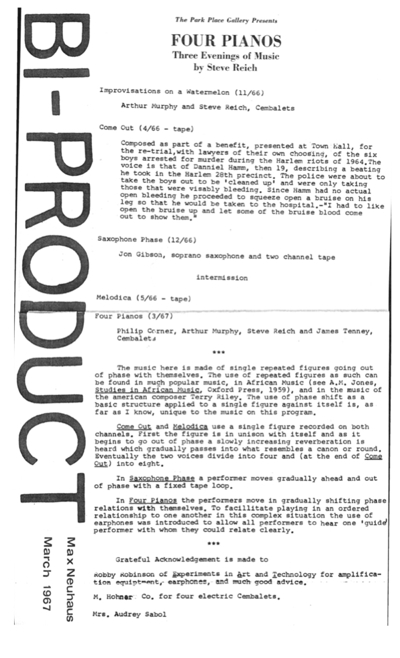 Park Place Gallery, programme 17-19 March 1967. The “Four Pianos” concerts also featured a tape composition by Max Neuhaus entitled Bi-Product. This work was not so much heard as it was composed during each concert. Neuhaus covered the floor of the gallery with white paper and as audience members wandered the gallery and cast shadows on the papered floor, the fluctuating light activated photoreceptor cells - (EAT News, Vol.1 n°2, June 1, 1967, p. 13) - mounted on the gallery’s ceiling. Newsweek’s Howard Junker described “a mess of wires, relays, and rectifiers” that converted electronic signals from these cells into sound, which was then recorded onto tape. At the end of the evening, audience members were given segments of tape, each with a short excerpt of the piece that they had collaboratively composed—that is, that had been composed as a “bi-product” of their attendance. Junker quoted Neuhaus, who declared, “I’m interested in process”—a noteworthy parallel to Reich’s interests over the coming years— then he complained: “It is now possible for a musician to use incredibly complex technology and produce nothing audible at all.” The primary effects of Neuhaus’ Bi-Product in concert were thus visual and tactile, namely the experience of walking on the papered floor, seeing the complex and inscrutable machinery, and carrying home the loop of plastic audiotape. — (Howard Junker, “Electronic Music—Wiggy,” Newsweek, 22 May 1967, 98) (According to David Allen Chapman, Collaboration, Presence, and Community : The Philip Glass Ensemble in Downtown New York, 1966-1976, Washington University in St. Louis, 2013) Click to enlarge 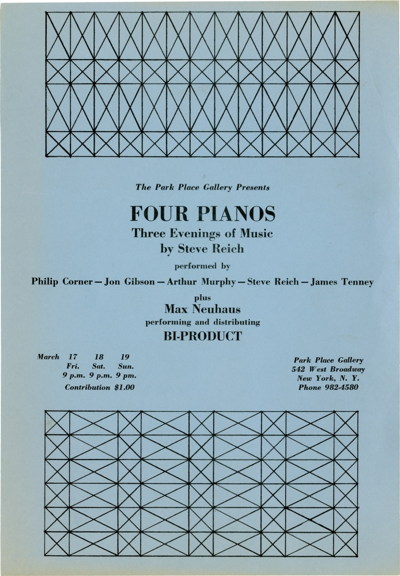 Park Place Gallery, programme 17-19 March 1967. Click to enlarge 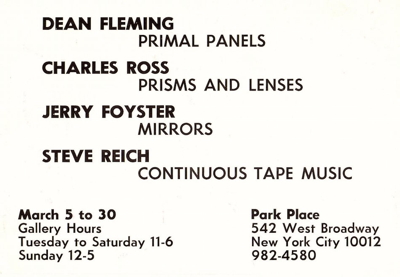 Park Place Gallery, flyer, group show, March 1967. |
| —— À son arrivée à New York, Steve Reich rejoignit un groupe d’artistes connu sous le nom de Park Place Group — Mark di Suvero, Peter Forakis, Robert Grosvenor, Tony Magar, Forrest Myers, Edwin Ruda, Leo Valledor, Dean Fleming, Tamara Melcher, et David Novoros —, dont la plupart d’entre eux avait aussi migré de San Francisco à New York. Ils ouvrirent un espace de travail collectif qu’il avaient nommé selon l’adresse du lieu : 79 Park Place dans le South Manhattan. Les membres du Park Place Group partageaient pas mal d’idées esthétiques de l’ère du temps, à l’époque space-age aux ambiances géométriques et colorées, que les critiques et historiens ont inclus dans une catégorie encore émergente, celle de l’art minimal. Pourtant ces artistes s’intéressaient à plus que simplement l’art visuel : les performances collaboratives jouaient aussi un rôle central dans leurs activités. Plusieurs des artistes du Park Place Group participaient à New York aux happenings et à la scène Fluxus autour de La Monte Young et de l’artiste lithuanien George Maciunas, ce qui représentait une extension logique des pratiques mixed-media qu’ils réalisaient lorsqu’ils étaient sur la Côte Ouest. Certains d’entre eux remodelaient leur loft, lieu d’habitation et de travail, en des espaces de galerie où, selon l’historienne en art, Linda Dalrymple Henderson, les amis art et musique pouvaient se développer ensemble dans le même espace. En novembre 1965, le Park Place Group déplaça leur loft-galerie art/musique à Greenwich Village et utilisèrent un vitrine au 542 West Broadway (aujourd’hui LaGuardia Place) : tout en gardant le même nom, la Park Place Gallery. Dean Fleming, peintre et saxophoniste et l’un des amis les plus proches de Steve Reich, l’invita pour travailler bénévolement en tant qu’ingénieur du son de la galerie, un petit boulot qui convenait bien à son background technique. À ce titre et dans ce cadre, Steve Reich composa sa prochaine œuvre majeure, Come Out. À la fin du mois de mai 1966, […] la Park Place Gallery accueillit le premier concert de Steve Reich depuis son arrivée à New York. Steve Reich présenta lors de ce concert ses œuvres pour bande magnétique et Melodica, qu’il venait juste de réaliser et de composer en un journée la semaine précédente. Steve Reich marque d’une pierre blanche l’année 1966 car pour lui c’est l’année durant laquelle débute sa carrière professionnelle, surtout grâce à ce premier concert fait à la Park Place Gallery. Au printemps 1967, la Park Place Gallery ouvre une exposition collective intitulée “Fleming / Ross / Foyster / Reich.” L'exposition annonçait : ‘Dean Fleming – Primal Panels / Charles Ross – Prisms & Lenses / Jerry Foyster – Mirrors / Steve Reich – Continuous Tape Music’, et se déroula du 5 au 30 mars 1967. L’exposition montrait des œuvres de différentes natures d’artistes du Park Place Group dans les intentions étaient de "réfléchir à l’engagement fondamental du rôle de l’espace dans la peinture et la sculpture". La vraie attraction était musicale, avec la présence de Steve Reich, dont le nom était dans le titre de l’exposition. Sa présence dans l’exposition était d’abord d’un ordre social et esthétique : ce qui a commencé comme une association entre des artistes et des musiciens avait finalement permis de travailler sur des analogies entre l'art et la musique. L’œuvre Melodica de Steve Reich, qui avait été créée l’année précédente aussi à la Park Place Gallery, était diffusée en boucle durant tout le temps de l’exposition (un mois). La critique du New York Times, Grace Glueck, avait chroniqué que les éléments minimaux mis ensemble formaient : " —— une sorte d’environnement architectural qui se définissaient sur les effets sonores (O.K., music) de Steve Reich. Pendant que vos yeux sont éblouis par les variations visuelles et lumineuses incessantes, vos oreilles sont saisies par le concert diffusé sur bande de M. Reich (musique), des figures répétitives jouées au Melodica (un instrument à vent et à anche avec un clavier), semblent être toutes aussi modulaires que les œuvres d’art présentées. Et en quelque sorte tout se tient très bien." —(in Glueck, “The Park Place Puts On a Stunner ; Show Mixes Melodica and 'Minimal' Art.”, New York Times, 11 March 1967, 25) Sur les recommandations du sculpteur Richard Serra, l’ancien collègue d’études de Steve Reich, Philip Glass, assista à l’un des concerts de la série “Four Pianos” en mars 1967. Philip Glass revenait tout juste de Paris où il avait suivi les master-classes de Nadia Boulanger et de Ravi Shankar. Les concerts à la Park Place Gallery lui fit une grande impression et c’est ainsi qu’il rencontra Steve Reich, qui à son tour le présenta à Jon Gibson et Arthur Murphy — tous deux membres fondateurs du Philip Glass Ensemble tout en jouant aussi dans Steve Reich & Musicians. (D'après David Allen Chapman, Collaboration, Presence, and Community : The Philip Glass Ensemble in Downtown New York, 1966-1976, Washington University in St. Louis, 2013 — et d'après Ross Cole, Sound Effects (O.K., Music) : Steve Reich and the Visual Arts in New York City, 1966–1968) | 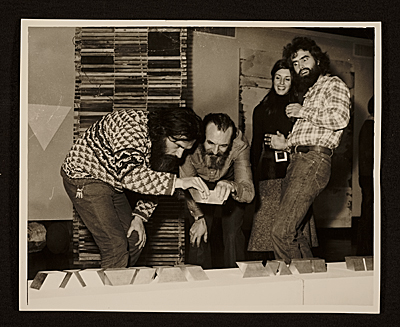 Peter Forakis, Bernie Kirschenbaum, Paula Cooper, and Chris Wilmarth 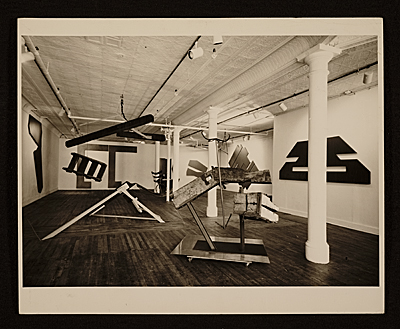 Installation of Mark di Suvero and David Novros at the Park Place Gallery 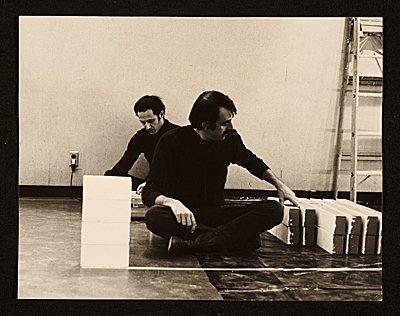 Steve Reich and William Wiley sitting on the floor (from Archives The Gallery of Art Research, Inc., and Paula Cooper Gallery records, 1961-2006. Archives of American Art, Smithsonian Institution - Artists of Park Place Gallery, ca. 1967-1968) |
Lire la suite - troisième partie / Continue reading - part3 - Slow Motion Sound (1967)
